
* In the 1950s, the US Air Force also decided to develop a SAM, the long-range ramjet-powered BOMARC, which served through the 1960s. In the 1980s, the US Army fielded a next-generation SAM, the "Patriot" series, which evolved into variants capable of intercepting short-range ballistic missiles Roughly in parallel, further research into ABMs during the Reagan Administration led to the development of an "upper tier" interceptor named THAAD that would deal with medium-range ballistic missiles, and a limited "National Missile Defense (NMD)" system to deal with long-range ballistic missiles
* One of the more interesting and controversial SAMs of the 1950s and 1960s was the Boeing BOMARC, which was fielded by the US Air Force, not the Army -- suggesting some elaborate turf battle at work. BOMARC a very long range missile that was described as a "pilotless interceptor", marking it as a USAF weapon system -- and indeed was originally given the USAF designation code of "XF-99", indicating an "experimental fighter" type.
BOMARC began as conceptual studies conducted by Boeing Aircraft for the Air Force in the mid-1940s under the title of "Ground To Air Pilotless Aircraft (GAPA)", in which a wide range of types of drones were considered for air defense use. GAPA was completed in 1949, and Boeing began development of an operational continental air-defense missile based on the studies, leveraging off research conducted by General Electric (GE) under the THUMPER program and the University of Michigan Aeronautical Research Center (MARC) under the WIZARD program. The new SAM project was designated "BOMARC", for "Boeing-MARC".
The BOMARC was a pilotless aircraft with a long, sleek, spikelike fuselage, clipped delta wings mounted high and towards the back, and a conventional tail assembly with similarly clipped delta surfaces. The wingtips pivoted to act as ailerons, while the tip of the tailfin pivoted to act as a rudder, and the "all-moving" tailplanes pivoted to act as elevators.
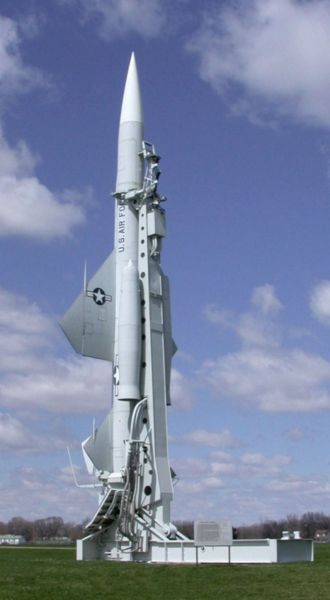
A Marquardt RJ43-MA-3 ramjet with 4,540 kilograms (10,000 pounds) thrust was mounted under each wing for supersonic cruise flight. An Aerojet LR59-AG-13 liquid-fuel rocket engine was built into the tail to provide launch boost. The rocket engine burned storable kerosene and nitric acid to provide 10,400 kilograms (23,000 pounds) thrust for a few seconds.
BOMARC was designed to operate at speeds of Mach 2 or above, at altitudes of 18,300 meters (60,000 feet) or more, and over ranges of hundreds of kilometers. The missile was stored horizontally on an erector inside a hardened "coffin" shelter, raised upright for firing, and then blasted straight up with its rocket motor, which accelerated it to flight speeds when the twin ramjets engines could take over.
The BOMARC was directed to its target by radio control, with terminal guidance performed by a Westinghouse DPN-34 radar seeker. It was one of the first SAMs to have a fully active radar seeker. The missile could carry a 450-kilogram (1,000-pound) conventional warhead, but was usually armed with a kiloton-yield nuclear warhead. The warhead was detonated by proximity fuze after authorization by ground control.
Initial flight of an F-99 BOMARC, using the Aerojet rocket but not the ramjets, was on 10 September 1952, but a flight using the ramjets was not performed until February 1955. By this time, it had been redesignated "IM-99" for "Interceptor Missile 99". On 25 October 1957, a BOMARC intercepted a target drone at a range of over 160 kilometers (100 miles) and an altitude of almost 20 kilometers (12 miles).
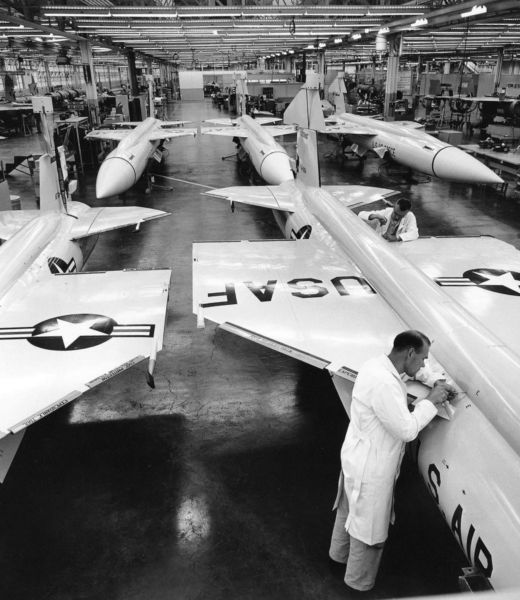
Boeing built 366 production first-generation BOMARC-As, as they were later called, from 1957 through 1960. BOMARC defense sites were set up at Dow Air Force Base (AFB) in Maine; Otis AFB in Massachusetts; McGuire AFB in New Jersey; and Suffolk County AFB in New York. Each site had one or two 28-missile squadrons. It was integrated into the SAGE system.
In 1962, the US military consolidated aircraft designation schemes, and the BOMARC-A was again redesignated, this time to "CIM-10A" for "Coffin Interceptor Missile 10A".
Boeing quickly moved on to an improved variant, the "IM-99B" (later "CIM-10B") BOMARC-B or "Super BOMARC". This featured uprated RJ43-7 ramjets with 6,350 kilograms (14,000 pounds) thrust, as well as a Thiokol M51 solid-rocket booster replacing the liquid-fuel booster. The solid-rocket booster provided 22,700 kilograms (30,000 pounds) thrust for half a minute, and then was discarded. The space originally taken by the liquid-fuel booster was refitted with fuel tanks to improve range. In addition, the original vacuum-tube electronics were replaced by solid-state electronics.
Boeing delivered 349 production BOMARC-Bs from 1961 through 1965. All four USAF sites were upgraded to the BOMARC-B, and new BOMARC-B sites were set up at Kincheloe AFB in Michigan; Duluth Municipal Airport in Minnesota; and Niagara Falls Municipal Airport in New York. The Royal Canadian Air Force (RCAF) also operated two BOMARC-B sites, one at North Bay, Ontario, and the other at La Macaza, Quebec. The RCAF BOMARCs were also fitted with nuclear warheads, under the control of USAF "authentification officers".
___________________________________________________________________
BOEING BOMARC-B (CIM-10B):
___________________________________________________________________
wingspan:
5.55 meters (18 feet 2 inches)
length:
13.7 meters (45 feet)
diameter:
88 centimeters (34.6 inches)
launch weight:
7,270 kilograms (16,030 pounds)
maximum speed:
Mach 3+
service ceiling:
30,500 meters (100,000 feet)
range:
725 kilometers (450 MI / 390 NMI)
___________________________________________________________________
About 200 retired CIM-10A BOMARC-As were converted to supersonic target drones designated CQM-10A. All BOMARCs were phased out of air-defense service by 1972.
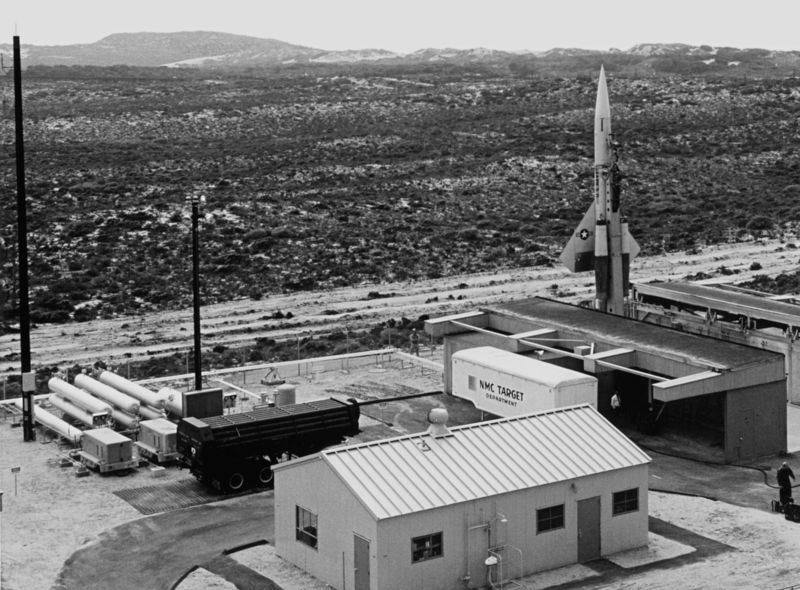
The BOMARC was a very advanced weapon for the time, and was reputedly temperamental. There are stories that its guidance system could be disrupted by trucks passing by a launch site. There is also an authenticated story that in 1961 one BOMARC-A suffered an accident that ruptured its rocket fuel tanks. The storable propellants were "hypergolic", meaning they started burning on contact, and the missile caught on fire. The fire was put out, but it was later realized that the missile's nuclear warhead was not designed to be "failsafe" in a fire and that it could have detonated. In any case, it was the only SAM developed and fielded by the USAF, with the US Army retaining its monopoly on land-based SAMs.
BACK_TO_TOP* In the early 1960s, the US Army began studies for an advanced SAM to replace the MIM-23 Hawk under the "Field Army Ballistic Missile Defense System (FABMDS)" program. It would undergo name changes, to finally be labeled "Surface to Air Missile / Development (SAM-D)" in 1964.
During the investigation phase, specifications were fluid and always changing -- but from the outset, the missile system was not only to be able to deal with aircraft, but also battlefield ballistic missiles. Raytheon was selected as prime contractor in 1967, with first test launches in 1969. In 1974, the program was redefined, with SAM-D to use "Track Via Missile (TVM)" guidance, in which it was launched towards a target as directed by a search radar, but zeroed in on the target using its own radar, with targeting data relayed back to the ground launch system. Since the missile was closing in on the target, it could "see" it better than a ground radar, and also more easily pick out decoys.
That delayed the program, with TVM demonstrated in 1975, and full development beginning in 1976, with the missile consequently named "XMIM-104A Patriot", with the name interpreted as "Phased Array Tracking Radar to Intercept On Target". Development proved challenging. The first production contract was issued in 1980, with the MIM-104A Patriot going into service in 1982.
* The Patriot, as it emerged, was a rocket of simple configuration, a big spike with four fins at the end. It was powered by a solid-fuel rocket motor and featured a blast-fragmentation warhead. Four were carried in box launchers on a M901 launch station, mounted on an M860 semi-trailer. The trailer had two axles and a power generator. Communications to the launcher were via VHF radio or a wired connection, the wired connection eventually becoming a fiber-optic link.
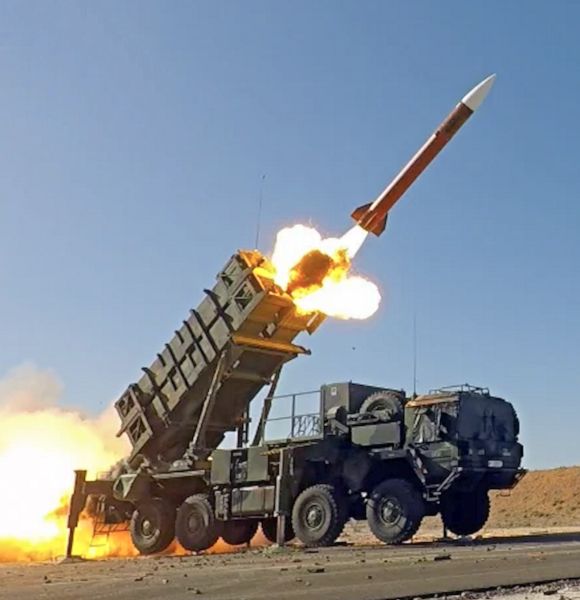
The ground station was organized around the AN/MPQ-53 G-band pulse-doppler phased-array multi-mode radar, with search, tracking, and identification friend or foe capabilities; it also included a datalink to the missile. The radar was under the direction of an AN/MSQ-104 Engagement Control Station (ECS) -- a truck-mounted van with the battery commander and a set of operators. The ECS command center assigned missiles to different targets and ordered their launch. A Patriot battery could also include an "Information Coordination Central (ICC)" vehicle that could coordinate multiple batteries and link them up to the larger battle system.
The missile was programmed with a flight trajectory before launch, following it with its inertial navigation system, with course updates provided by the radar. That allowed one radar system to keep multiple missiles on track. In terminal attack, the missile's radar seeker provided data to the radar, which could help the missile sift through decoys and optimized the attack. The warhead was detonated by a proximity fuze.
_______________________________________________________________
RAYTHEON MIM-104A/B PATRIOT:
_______________________________________________________________
finspan:
83 centimeters (33 inches)
length:
5.31 meters (17 feet 5 inches)
diameter:
41 centimeters (16 inches)
launch weight:
900 kilograms (2,000 pounds)
maximum speed:
Mach 5
service ceiling:
24,000 meters (80,000 feet)
range:
70 kilometers (43 MI / 38 NMI)
_______________________________________________________________
* In the late 1980s, the Patriot system was updated to the first "Patriot Advanced Capability (PAC)" configuration, with software changes to improve the system's ability to intercept SRBMs. PAC-1 was first tested against a Lance tactical ballistic missile in 1986, and was fielded from 1988. In parallel, the Army developed the improved "MIM-104B" missile variant, which added an anti-jamming seeker to allow the missile to attack a ground-based jamming system. PAC-1 had little to do with the missile itself, and so worked with both the MIM-104A and MIM-104B.
The Patriot system was then updated to the "PAC-2" configuration, with further software changes. The missile was updated to the "MIM-104C" configuration in step with the PAC-2, with the MIM-104C featuring a warhead with substantially bigger fragments to be more effective, and a radar proximity fuze with dual beams -- a narrow beam for SRBMs, a wide beam for aircraft. Test firings of the MIM-104C began in 1987, with the PAC-2 system fielded in 1990.
During the Gulf War in 1991, the Patriot was used against Iraqi Al-Hussein -- modified Russian SS-1 Scud -- SRBMs, with two Patriots typically fired against each Al-Hussein. At the time, the Patriot seemed highly effective, but later analysis showed it was not as hot as it was thought to be -- and the Al-Hussein was an antiquated weapon in the first place.
After the war, in 1993 the Army upgraded PAC-2 to a support remote launch capability, allowing launchers to be deployed up to 10 kilometers (6 miles) from the radar / ECS. That made the launchers harder targets; more importantly, it multiplied the footprint that a Patriot battery could defend by a factor of 5.
The next year, 1994, the Army introduced the "MIM-104D" upgrade, or "PAC-2 Guidance Enhanced Missile (GEM)". It featured a faster-detonating fuzing system to allow it to better engage SRBMs, and a seeker that gave it better ability to spot stealthy targets. A "MIM-104E" upgrade was introduced to service in 2006, with further refinements in both fuzing and seeker.
* In the meantime, the Army was working towards a "PAC-3" system that was to meet the expectations for which Patriot was designed. It was introduced in three phases:
Configuration 3 also included a new-design Patriot missile, the "MIM-104F" -- often called the "PAC-3" missile, though it wasn't available for Configuration 1 and Configuration 2. It was effectively a new design, as long as the MIM-104D, but much more slender. It was a "hit to kill (HTK)" weapon: the engagement window against a ballistic missile was so narrow that a traditional warhead would need to be precisely targeted and detonated. The MIM-104F, which used a high-resolution millimeter-wave radar seeker, was capable of directly hitting a ballistic missile -- though it still retained a warhead of sorts, using a small explosive charge to disperse 24 tungsten fragments, something like a shotgun shell.

The MIM-104F began life as the "Flexible Lightweight Agile Guided Experiment (FLAGE)" demonstrator, which was flight-tested from 1988. It was refined into the refined "Extended Range Intercept Technology (ERINT)" demonstrator, which was the basis for the MIM-104F, which was test-fired from 1997. The MIM-104F didn't fully replace the PAC-2 GEM, which was still lethal for aircraft targets. The MIM-104F could be fired from the same launcher as the PAC-2 GEM, with 16 missiles instead of 4. The launcher could also handle two PAC-2 GEMs on one side and 8 MIM-104Fs on the other.
From 2009, test flights were conducted with the "PAC-3 Missile Segment Enhancement (MSE)" version of the MIM-104F, with a larger rocket motor that almost doubled range, and bigger fins to improve agility. PAC-3 MSE was fielded from 2016, and has generally replaced the original PAC-3 missile. Twelve PAC-3 MSE missiles could be carried on a launcher; a launcher could also have six PAC-3 MSE missiles on one side, and two PAC-2 GEM missiles on the other.
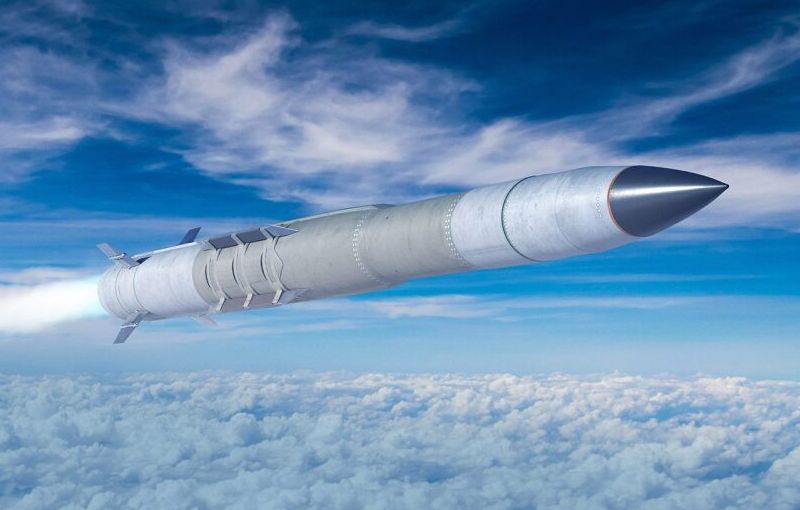
The Patriot system was obtained by many US allies, including Bahrain, Germany, Greece, Israel, Japan, Kuwait, the Netherlands, Poland, Qatar, Romania, Saudi Arabia, South Korea, Spain, Sweden, Switzerland, Taiwan, and the UAE. Patriots have seen some action in foreign hands:
Following Russia's invasion of Ukraine in early 2022, the Patriot ended up being a critical weapon in protecting Ukraine from Russian drone, cruise missile, and missile attacks. There were also incidents of Russian aircraft being shot down at long range, but what they were hit with was not revealed. Unfortunately, it proved difficult to manufacture Patriot missiles quickly enough to keep up with the Russian onslaught.
* A multinational collaboration was established in the 1990s between US, Italy, and Germany to develop an improved PAC-3 based air defense system, designated the "Medium-Extended Air Defense System (MEADS)". MEADS included:
One particular distinction of MEADS was that it was highly mobile, with elements able to remain in near-continuous motion. The program was formally initiated in 2005, with the Germans committing to field it in 2015. It has also been fielded by Italy and Poland. The truck launchers were obtained by Ukraine in their fight against the Russians, with the launchers able to "shoot & scoot" to avoid counterstrikes. Incidentally, the Russians claimed the destruction of a good number of Patriot systems -- but the Ukrainians liked to build convincing decoys, and it's not clear the Russians destroyed any real Patriot launchers.
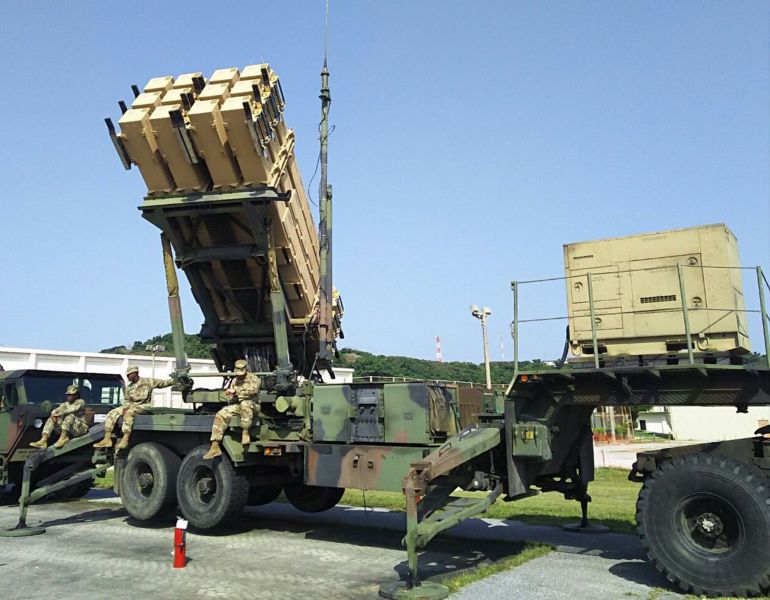
* As a footnote to the Patriot story, there was also an effort to develop a surface-to-surface missile based on it -- as part of the "Assault Breaker" program, a US military program intended to develop long-range precision munitions that could defeat a major Soviet ground offensive.
Work on Assault Breaker began in 1977, with two missiles selected for experimentation: the Martin Marietta "T-16", based on the Patriot, and the Vought "T-22", based on the MGM-52 Lance tactical ballistic missile. Both missiles could carry 20 "smart" anti-armor submunitions and had ranges of about 100 kilometers (60 miles) for the T-16 and 120 kilometers (75 miles) for the T-22. In principle, the T-16 could also be air-launched. There were 14 test shots in 1981:1982, including 10 for the T-16 and 4 for the T-22. The program turned out to be too ambitious and was then abandoned.
BACK_TO_TOP* The Patriot system covers mid-range air defenses; the Army has a capability gap in short-range air defenses. Up to the 1990s, the Army relied on the Chaparral-Vulcan short-range tactical air defense system, featuring two tracked vehicles, both derived from the M113 armored personnel carrier:
Both were optically-aimed, though the VADS did have a ranging radar, and both were eventually given night vision gear.
Since they were retired, short-range air defense was mostly relegated to the "FIM-92 Stinger" infantry-portable heat-seeking SAM -- notably carried by the "AN/TWQ-1 Avenger" system, with eight Stingers in a turret on a Humvee truck chassis. Although it did not have targeting sensors itself, it could be linked to other platforms to cue its attacks. The Avenger is still in service; Stinger needs to be discussed in detail elsewhere. There was also work on a truck-mounted launcher for the AIM-120 AMRAAM missile, known as the "Surface-Launched AMRAAM (SLAMRAAM)" system, but it did not go into general US Army service.
In recent years, the Army decided to pay more attention to neglected short-range air defense, with a hierarchy of systems being developed, all to be integrated by the IBCS system. At the bottom of the hierarchy is the "counter-small unmanned aerial system (C-UAS)", based on the Raytheon "Coyote" missile.
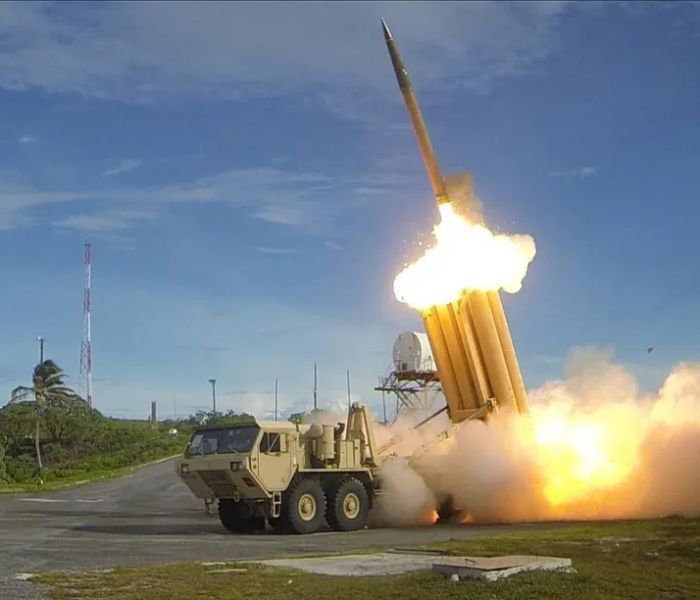
Raytheon introduced the "Coyote" small drone almost two decades ago. It was powered by a pusher prop, had "switchblade" wings fore and aft plus twin pop-up tailfins, and could be used for intelligence-gathering or as a kamikaze drone. It was fired from a box launcher. The Army then modified the Coyote as an anti-drone interceptor, changes including a target seeker and a proximity-fuzed warhead. It looked very much like the original Coyote drone, except for a bulbous nose. It went into service in 2019 as the "Howler C-UAS", being coupled with the Raytheon "Ku-Band Radio Frequency System (KuRFS)".
This initial "Coyote 1B" C-UAS interceptor was just a stopgap while Raytheon worked on the "Coyote 2", now in service. The Block 2 Coyote no longer looked like a drone, featuring cruciform tailfins and strake wings. It was launched with four rocket boosters on its tail and flew under turbojet power. It had a range of up to 15 kilometers (9 miles), a top speed of 595 KPH (370 MPH), and was smart enough to re-engage targets if it missed the first time.
The Army fielded mobile and fixed position Coyote counter-drone systems under the designations of the "Mobile, Low, Slow, Unmanned Aircraft Integrated Defeat System (M-LIDS)" and "Fixed Site LIDS (FS-LIDS)":
The next level above LIDS is the "Maneuver Short-Range Air Defense (M-SHORAD)" system, currently based on the Stryker with an M240 MAG 7.62-millimeter machine gun, a 30-millimeter automatic cannon, four Stingers, and two Hellfire anti-armor missiles -- which can also be used to take down helicopters. The M-SHORAD can engage both air and surface targets, and includes a radar for warning and engagement. An improvement program is eliminating the two Hellfires and adding four more Stingers; a program to obtain a replacement for the Stinger, with possible multi-role capability, is also in progress.

At the leading edge of M-SHORAD is the Raytheon "Directed Energy Maneuver-Short Range Air Defense (DE M-SHORAD)" system, also based on the Stryker, but carrying a 50-kilowatt laser. It has been operationally tested and has proven effective against drones, though operator feedback suggested it wasn't really ready for field service.

Above M-SHORAD is the "Enduring Shield" system, which hasn't been fielded yet -- using the AIM-9X Sidewinder as a mid-range SAM, reserving the Patriot for long-range engagement. The 18-round Enduring Shield launcher was based on an earlier design known as the "Multi-Mission Launcher (MML)" -- the Enduring Shield launcher being palletized and capable of being carried on a range of vehicles, and able to fire a range of different munitions. Work is underway for a more optimized missile than the AIM-9X, being about the same size but with substantially more range and capability. The Army's air-defense thinking continues to evolve, with other systems being considered for integration.
BACK_TO_TOP* The Patriot system was designed from the outset as capable of intercepting SRBMs, but it was never seen as a useful defense against strategic missiles. As noted, the US gave up on ABM defense systems in 1976 -- but in the 1980s, US President Ronald Reagan embraced the concept again, passionately believing there had to be an alternative to the ugly logic of nuclear deterrence.
After lobbying by missile-defense advocates, in 1983 Reagan announced that the US would start a major research program to determine if missile defense was practical. Initial studies led to the formation of the Strategic Defense Initiative (SDI) or "Star Wars" in early 1984, with research and development effort was conducted by the Strategic Defense Initiative Organization (SDIO). Work then went forward on HTK interceptors -- as well as more speculative technologies, such as particle beam weapons, high-power conventional lasers, and orbiting X-ray lasers that were "pumped" by nuclear explosions. The speculative concepts were unpromising, with leading-edge work on the less ambitious "Brilliant Pebbles" scheme.
Brilliant Pebbles envisioned a large constellation of orbiting HTK interceptors. This was not an entirely new idea, since a similar concept had been investigated in the late 1950s and early 1960s under the name "Ballistic Missile Boost Intercept (BAMBI)", which featured HTK interceptors. Although paper studies of BAMBI painted an optimistic vision of its potential, in hindsight it was beyond the leading edge of the technology of the time. Even if it had been realistic, it would have been wildly expensive, and it was canceled during the Kennedy Administration.
Brilliant Pebbles updated BAMBI by adding the concept of a "distributed network", borrowed from computing. Instead of building a defensive system around high-value centralized assets, the Brilliant Pebbles plan envisioned an orbiting network of thousands, or even tens of thousands, of small, cheap, mostly autonomous battle stations. Each of the Brilliant Pebble battle stations would have an on-board sensor and a processor to allow it to spot the exhaust of an ascending ICBM. The battle station would then fire an HTK interceptor to destroy the missile. Prototype interceptors missiles were developed and tested in lab environments.
Brilliant Pebbles gradually bogged down in criticisms; it promised to be expensive, far more expensive than its advocates claimed, and very tricky to get to work right. One particular problem was the orbital battlestations: the military did not like the idea of uncrewed missile-launch platforms that could, in principle, fire on anything if they were afflicted by a bug. British intelligence, obtaining information through "moles" in the Soviet government, found that the leadership of the USSR had been thoroughly panicked by the announcement of SDI, believing from the program and Reagan's noisy anti-Soviet rhetoric that the US was preparing to attack the Soviet Union. By the late 1980s, Soviet intelligence had convinced the leadership that SDI was unworkable.
The collapse of the Soviet Union in the early 1990s finally eliminated most of the rationale for SDI. With the end of the USSR, American defense budgets were cut, and the US military was forced to focus its constrained resources on more immediate requirements. A Brilliant Pebbles network was no longer realistic, and in 1993 the name of SDIO was accordingly changed to the more modest title of the "Ballistic Missile Defense Organization (BMDO)".
* Brilliant Pebbles was officially dead, but research on missile defense technologies continued on a limited basis. In 1987, even before the end of Star Wars, the US Army began an investigation into the "Theater [later Terminal] High Altitude Air Defense (THAAD)" system that could hit MRBMs coming in at high altitudes. Lockheed Martin was selected to develop THAAD, with BMDO taking over the program. Test firings were conducted from 1995, with initial fielding in 1998.
THAAD, as it emerged, was based on a finless, spike-like missile with a length of 6.2 meters (20 feet 4 inches) and a launch mass of 900 kilograms (a ton). The missile featured a lightweight HTK vehicle, with a cooled infrared sensor, chilled immediately after launch. THAAD was derived from a demonstrator, the "Exoatmospheric Reentry Vehicle Interception System (ERIS)", that hadn't been successful.
THAAD was alerted to use by the "Space-Based Infra-Red System (SBIRS)" satellite constellation, which could track missiles from their heat emissions. Once the incoming missile came within range, THAAD ground-control radars would track the targets. The THAAD radar was a high-frequency X-band system designated the "AN/TPY-2", built by Raytheon, which could provide a detailed radar image of the target.
THAAD interceptors were fired from launchers carried on HEMTT four-axle heavy trucks, with each launcher stowing eight missiles. The launch system was designated "M1075". A typical THAAD battery had nine M1075s, two mobile command centers, and a single AN/TPY-2 radar. The command centers had datalinks to allow them to hook into a wide-area defense system.
After launch, THAAD was guided to the vicinity of the target by the missile's autopilot, with course corrections as determined by satellites and the tracking radar, relayed over a datalink. Once the interceptor reached an altitude of about 40 kilometers (25 miles), the booster portion of the missile fell away, with the hit-to-kill vehicle continuing on an intercept course. The kill vehicle was controlled by thrusters ringing its center of mass. When it reached a certain range from the target, the kill vehicle opened a seeker head with a gimbaled infrared imaging array. THAAD used an infrared seeker because it attacked targets above the weather, while the lower-altitude PAC-3 was instead designed with a millimeter-wave radar seeker to locate targets in clouds.
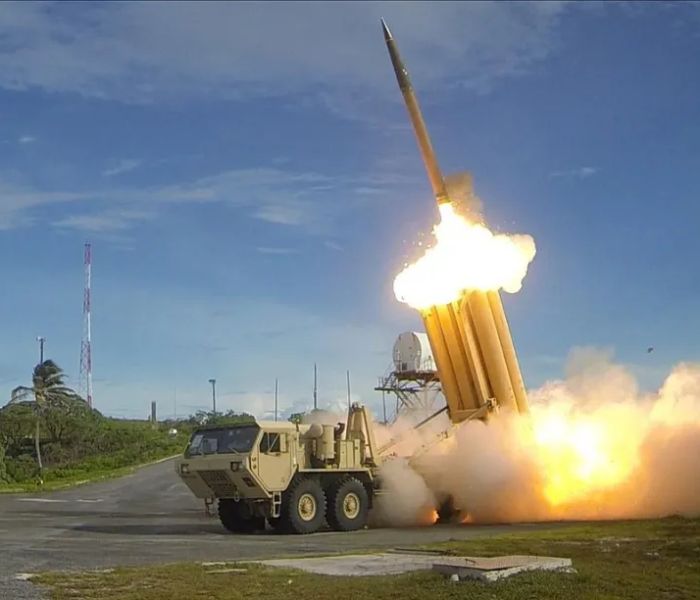
The range of THAAD was estimated at 200 kilometers (125 miles), with the missile able to perform intercepts at up to altitudes of 150 kilometers (95 miles). One or two THAADs would be fired to try to destroy the target at high altitude; if they failed, several PAC-3s would be fired to destroy it at closer range. The assumption was that a single THAAD was unlikely to score a kill.
Early THAAD tests did not go well, but the system achieved initial operating capability in 2009: a battery was set up in Hawaii to deal with potential missile attacks by North Korea. THAAD batteries have been deployed to Israel, Romania, and South Korea; the UAE has purchased the system. THAAD is now the top-end element of IBCS. Consideration is being given to development of a more powerful booster rocket, with a diameter of 53 centimeters (21 inches) as compared to the original 37 centimeters (14.5 inches), along with a second "kick stage", to significantly increase range.
* While THAAD was in development, the US Navy was pursuing a comparable weapon under the "Navy Theatre Wide (NTW)" effort, based on the USN's long-standing Standard series of SAMs and using the Navy's Aegis cruisers and destroyers as launch platforms. The end result was the "Standard SM-3" sub-series of missiles, like THAAD focused on upper-tier defense and using an HTK warhead. The SM-3 is discussed later.
BACK_TO_TOP* Work on tactical missile defense (TMD) systems like THAAD and NTW was paralleled by work on a US national missile defense (NMD) system. Conservative think-tanks envisioned a range of missile defense scenarios, such as ships carrying loads of ABM interceptors steaming off the coasts of America, able to launch missiles cued by orbiting satellite missile warning and tracking networks, and new ground-based radars.
Military officials working on TMD were nervous about the push for NMD, since it muddied the waters for efforts to deal with battlefield missiles. However, the potential threat of ICBMs in the hands of smaller powers gave NMD advocates in the US Congress and the military a lever to push for fielding a pilot NMD system. BMDO initiated an NMD investigation program, with Boeing as the prime system contractor.
Early NMD tests brought the missile defense issue back into the headlines and onto the first rank of issues for the Clinton Administration, and proved a political quagmire, with sniping from Congress on various rationales, the Russians and Chinese objecting, while the Europeans seemed indifferent. The issue was passed on to the Bush II Administration, which pushed for deployment of an NMD system, and then pulled out of the ABM Treaty -- President George Bush saying the ABMT was a "relic" that blocked timely missile defense testing and deployment, which was judged "indispensable" as a defense against terrorists and rogue states. At the end of 2002, the administration gave the go-ahead for operational development and deployment.
The core of the NMD system was a Raytheon HTK interceptor, designated the "Exoatmospheric Kill Vehicle (EKV)", designed to attack missiles at altitudes of hundreds of kilometers. Space-based intercept is trickier in some ways than atmospheric intercept, since balloon decoys and chaff remain effective until the RV enters the atmosphere.
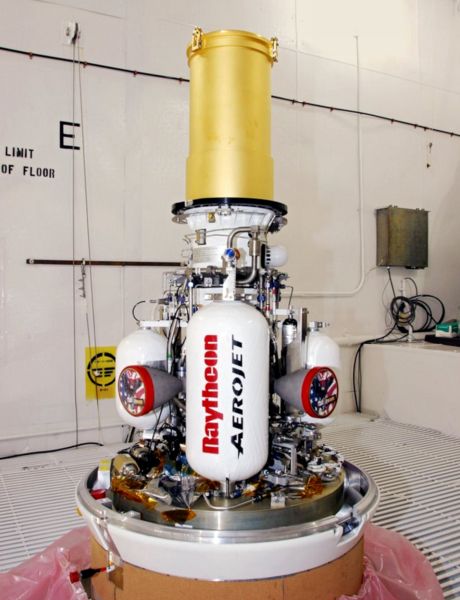
The EKV included a 256-by-256 pixel mercury cadmium-telluride infrared imaging array, and a hydrazine-thruster space maneuvering system. The EKV was launched from the ground by a multistage booster to hit targets in space. The EKV has since been improved, one possible addition being a lidar (laser radar) sensor.
The deployed NMD system was to rely on an early-warning satellite network. The older "Defense Support Program (DSP)" early-warning satellite network was used at first, but was to be replaced by the USAF "Space Based Infrared System (SBIRS)" satellite constellation. As conceived, SBIRS was to have two components:
NMD tests began in 1999, initially with the EKV launched by surplus Minuteman II ICBMs from Kwajalein Atoll in the central Pacific, against surplus Minutemen used as targets. Tests over the next decade had mixed results, but by 2008 the system was judged effective -- at least against a small number of targets that lacked countermeasures.
The Minuteman booster used to launch the EKV in the initial tests was just a stopgap. Development of the production "Ground Based Interceptor (GBI)" originally followed two tracks, one at Boeing that was later handed off to Lockheed Martin, the other at Orbital Sciences (OSC) -- Orbital now being part of Northrop Grumman. The Lockheed Martin GBI never flew and was ultimately canceled. The OSC GBI performed its first flight in February 2003, with following tests again having mixed results but working towards maturity.
The GBI, as it emerged, was a three-stage solid-fuel missile, derived from other OSC boosters. It was a relatively big weapon, 16.8 meters (55 feet) long, 1.27 meters (4 feet 2 inches) in diameter, with a launch weight of 12.7 tonnes (14 tons). It had an astounding ceiling of 2,000 kilometers (1,250 miles). The GBI initially carried the Raytheon EKV as its payload. Incidentally, OSC also developed targets for GBI tests, with the targets based on off-the-shelf solid rocket boosters.
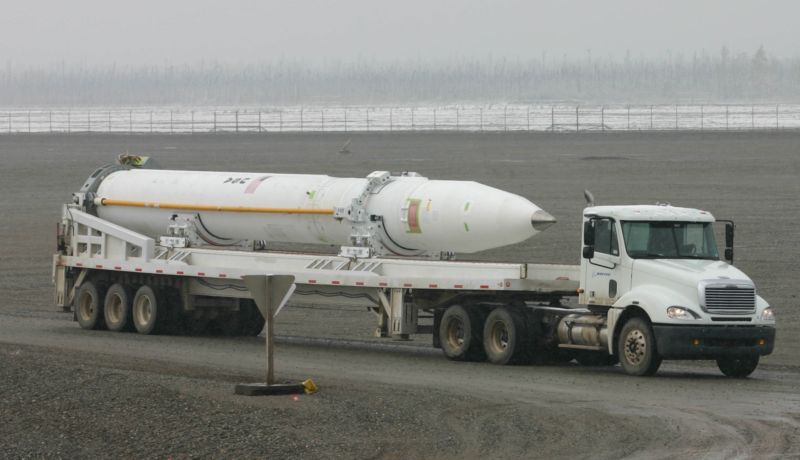
Under the "Ground-Based Midcourse Defense (GMD)" system, missiles have been sited, with 30 in place at Fort Greeley, Alaska, and 30 more at Vandenberg Air Force Base in California. The Fort Greeley missiles are supported by the "Sea Based Radar (SBR)", an X-band radar on a floating platform, while the Vandenberg missiles are supported by a ground-based X-band radar at Beale AFB in California. This would give a defense shield against "northeast Asia" (read as "North Korea"). There was talk of setting up a GMD system in Eastern Europe to counter Iran, but the conclusion was to set up THAAD or Aegis Ashore batteries in select US allies.
The STSS and SBIRS satellite systems are to be replaced by next-generation systems, details being confused by organizational changes -- mostly due to the creation of the US Space Force (USSF) in 2019, primarily out of the US Air Force's space functions -- incidentally, Vandenberg AFB is now a Space Force Base. The USSF absorbed the MDA, as well the Pentagon's Space Development Agency (SDA), also created in 2019. In any case, the follow-on programs are diverse and confusing:
Since this is a work in progress, it is subject to change. The satellites will integrate with the "Upgraded Early Warning Radar (UEWR)" early-warning system -- which is BMEWS with modernized technology. Farther down the road, there's talk of a space-based radar network.
Since one of the objections to NMD is the difficulty of intercepting multiple warheads or warheads protected by decoys, further development work was done on a "miniature kill vehicle (MKV)", about the size of a coffee can, with a weight on the order of 5 kilograms (11 pounds), and fitted with an infrared imaging array. A single interceptor missile would carry a cluster of dozens of MKVs, programming them to attack individual targets before dispersal and then providing them with command updates after dispersal. Lockheed Martin was awarded an initial MKV development contract in early 2004, with Raytheon then taking over the exercise later.
The MKV effort did not go well, however, and was canceled in 2019, with the EKV remaining in use. The concept was then revived as the "Next-Generation Interceptor (NGI)", a more comprehensive upgrade of the GBI. The NGI will be fielded from 2028.
BACK_TO_TOP